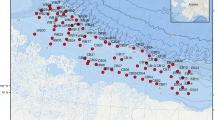Abstract
The distribution of epibenthic penaeid prawn postlarvae has previously been shown to relate to the degree of marine influences in the flora, sediment and water conditions in littoral and infralittoral habitats in Moreton Bay. The postlarvae are part of a complex faunal assemblage of approximately 400 mobile epibenthic species. Samples of the assemblage from stations situated throughout Moreton Bay were analysed by multivariable methods, to detect whether the environmental influences volated to the distribution of penaeid prawns, were related to the fauna as a whole. This was found to be so. The fauna occurred in two groups in areas of either less marine or more marine influences. Animals in the first group were less diverse, with distributions unrelated to depth or presence of seagrasses, but related to the level of marine influences between geographical areas sampled. Animals in the second group were closely related to depth and presence of seagrasses, but no overall differences were attributable to marine influeces apart from those attributable to depth. Temporal changes in species composition were smaller than spatial changes, and changes in relative abundance were, in both groups, related to differences between (i) summer and winter, and (ii) spring and the rest of the year.
Similar content being viewed by others
Literature Cited
Coleman, N., W. Cuff, M. Drummond and J.D. Kudenov: A quantitative survey of the macrobenthos of Western Port, Victoria. Aust. J. mar. Freshwat. Res. 29, 445–466 (1978)
Dale, M.B., G.N. Lance and L. Albrecht: Extensions of information analysis. Aust. Comput. J. 3, 29–34 (1971)
Ehright, J.T.: Climate and population regulation. The biogeographer's dilemma. Oecologia 24, 295–310 (1976)
Gower, J.C.: Some distance properties of latent root and vector methods used in multivariate analysis. Biometrika 53, 325–338 (1966)
Lance, G.N., P.W. Milne and W.T. Williams: Mixeddata classificatory programs III. Diagnostic systems. Aust. Comput. J. 1, 178–181 (1968)
Livingston, R.J.: Time as a factor in biomonitoring estuarine systems with reference to benthic macrophytes and epibenthic fishes and invertebrates. In: Biological monitoring of water and effluent quality, pp 212–234. Ed. by J. Cairns, Jr., K.L. Dickson and G.F. Westlake. Philadelphia: American Society for Testing Materials 1977
Mayo, K.: Program Divinfre: A divisive classification on binary data, including re-allocation. Tech. Mem. Div. Land Res., C.S.I.R.O. Aust. 72 (4), 1–10 (1972)
Newell, B.S.: The hydrological environment of Moreton Bay, Queensland, 1967–68. Tech. Pap. Div. Fish. Oceanogr. C.S.I.R.O. Aust. 30, 1–35 (1971a)
—: Chlorinity and temperature distribution in Deception Bay, Queensland, 1968–69. Rep. Div. Fish. Oceanogr. C.S.I.R.O. Aust. 49, 1–7 (1971b)
Robertson, A.I.: Ecology of juvenile King George whiting Sillaginodes punctatus (Cuvier and Valenciennes) (Pisces: Perciformes) in Western Port, Victoria. Aust. J. mar. Freshwat. Res. 28, 35–43 (1977)
Steel, R.G.D. and J.H. Torrie: Principles and procedures of statistics, 481 pp. New York: McGraw Hill 1960
Stephenson, T.A. and A. Stephenson: The universal features of zonation between tidemarks on rocky coasts. J. Ecol. 37, 289–305 (1949)
Wadley, V.A. and P.C. Young: Distribution and abundance of epibenthic faunal species collected from the littoral and infralittoral fringes of Moreton Bay, Queensland, 1972–1973. Microfiche Data Ser. Div. Fish. Oceanogr., C.S.I.R.O. Aust. 2, (1978)
Williams, W.T.: Principles of clustering. A. Rev. Ecol. Syst. 2, 303–326 (1971)
—: Pattern analysis in agricultural science, 331 pp. Melbourne: CSIRO/Elsevier 1976
—, J.M. Lambert and G.N. Lance: Multivariate methods in plant ecology. V. Similarity analyses and information-analysis. J. Ecol. 54, 427–445 (1966)
Williamson, M.: The analysis of biological populations, 180 pp. London: Arnold 1972
Young, P.C.: Preliminary observations on the environment and biology of juvenile king prawns (Penaeus plebejus) in Moreton Bay, Queensland. In: Australian National Prawn Seminar, Maroochydore, 1973, pp 18–36. Ed. by P.C. Young. Canberra: Australian Goverment Publishing Service 1975
—: Moreton Bay, Queensland: A nursery area for juvenile penaeid prawns. Aust. J. mar. Freshwat. Res. 29, 55–75 (1978)
— and S.M. Carpenter: The recruitment of postlarval penaeid prawns to nursery areas in Moreton Bay, Queensland. Aust. J. mar. Freshwat. Res. 28, 755–783 (1977)
— and H. Kirkman: The seagrass communities of Moreton Bay, Queensland. Aquat. Bot. 1, 191–202 (1975)
Author information
Authors and Affiliations
Additional information
Communicated by G.F. Humphrey, Sydney
Rights and permissions
About this article
Cite this article
Young, P.C., Wadley, V.A. Distribution of shallow-water epibenthic macrofauna in Moreton Bay, Queensland, Australia. Mar. Biol. 53, 83–97 (1979). https://doi.org/10.1007/BF00386532
Accepted:
Issue Date:
DOI: https://doi.org/10.1007/BF00386532




